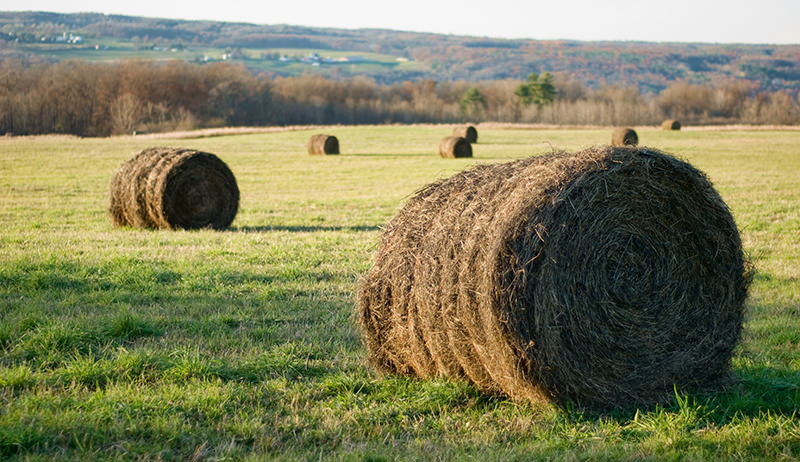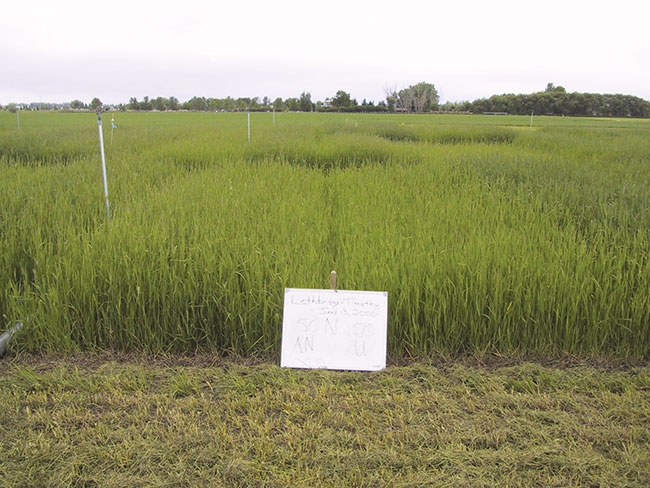What Is the Best Fertilizer for Hay Field
The 1 best thing for our grass is compost but thats expensive for us with our acreage. On fields with a good stand of a responsive species apply 90 to 100 pounds per acre of actual nitrogen equal to about 200 pounds of urea or 300 pounds of urea ammonium nitrate UAN Thomas reminds producers that the nitrogen in manure is as good as fertilizer nitrogen but applications made during this time of year often risk cutting up soft fields.

How To Grow Quality Hay Hobby Farms
Commonly used N fertilizers for grass hay production include urea or ammonium sulfate.

. As grass hay harvest gets underway we need to be thinking about fertilizing those stands with nitrogen N. All the common N fertilizer products ammonium nitrate urea urea ammonium sulfate urea ammonium nitrate solution work well. The ideal ratio of fertilizer for this type of hay-producing field would be one part phosphorus to four parts potassium.
Fertilizer should be applied at least three days after cutting hay. Then in Fall there is the seaweed and light application of corn gluten. Usually 20-40 pounds per acre will stimulate legume growth nicely in most hay meadows.
If your soil is testing low on nutrients it is important to fertilize phosphorus at 15 to 4 times the removal rate by hay. A soil test can tell you how much phosphorus to use. For sandy soils around 05 to 1 lbs would be sufficient.
If grazing apply Hay-Now every 30 to 45 days. Producers will consider the rate source and place of application again when deciding when to apply fertilizers to hay fields or pastures. Purchasing hay and bringing nutrients onto the farm can be a cost effective addition of fertilizer to the farm.
Commonly used N fertilizers for grass hay production include urea or ammonium sulfate. If possible N fertilizer should be applied early in the spring even before grass begins active growth. Nitrogen phosphate and potassium fertilizer recommendations.
If cutting apply Hay-Now after every cutting with 2 to 3 inches of re-growth. In between first and second cut works for most hay types and most types of fertilizer. These legumes then will help supply some nitrogen to the grasses in your meadow and the hay you cut from this meadow will yield more and contain more protein than straight grass hay 2.
To fertilize hay pick an NPK fertilizer with a good amount of all the essential three macro-nutrient. A 5050 liquid blend of urea and ammonium nitrate. Urea with 46 N is the most concentrated commercial source but must be applied shortly before rain or irrigation to prevent significant loss of the N to the atmosphere as volatile ammonia.
If you can only afford lime or fertilizer but not both apply the lime. Producers should use a feed analysis of purchased feed to determine its fertilizer value. If two cuts are planned then the total N to be applied.
Several forage grasses and grass mixtures have adapted to Minnesota. Producers can also use liquid N fertilizer 28-0-0. Fertilizer should be applied as soon after cutting as practical.
More than half the soil samples for forage tested at the laboratory at Auburn University have a pH too acid for best production and need agricultural limestone to correct this. Allowing the plants to recover and have some new green leaves will increase photosynthetic activity and will increase nutrient uptake. When using the Hay-Now program an early-season application of 12 gallon Montys Liquid Carbon is suggested for best results.
Fertilizing with ammonium sulfate or with. THE HAY-NOW PROGRAMFoliar apply Hay-Now anytime from early spring green-up thru fall. Otherwise you will only be getting yields between 40 and 60 of total hay potential from your fields.
Less available with low pH Fertilizer nutrients are less available when the soil pH is low. Then fertilize with phosphorus. Also predictable weather patterns affect the timing of fertilizer.
The most efficient way to fertilize these grass hay stands is to split-apply N based on the expected yield of the next growth. As with other crops you need adequate fertilizer programs for. Hay generally removes between 8-16 lbs P2O5acre for one ton of hay depending on your soil type.
When looking at adding these essential nutrients back in the hay composition that of mostly grass or mostly legumes is going to dictate the nutrients you focus on most and the rate you apply. You can use poultry manures but we sell hay sometimes and have to use well composted litter for health safety. Producers can use dry matter crude protein phosphorous and.
Fertilizers for Grass and Hay. When only one cut is taken for hay all N fertilizer should be applied in early spring. If urea or UAN are used applying them.
Nutrient guidelines for Minnesota grasses for hay and pasture. This will be dependent on plant species variety and planting date. The actual rate should be 50 pounds N per ton of expected hay yield.
Optimal rates of phosphorus also increase leaf. The vast majority of fertilizer costs for crop production are for application of nitrogen phosphorous and potassium. Nutrients should be applied when plants are actively taking up nutrients from the soil.
Liquid N can be successfully dribble-banded onto grass in spring but urea in the liquid is subject to. For every ton of legume or tall grass hay harvested from a hayfield roughly 50 pounds of potassium and 13 pounds of phosphorus is removed from the soil. If more than one cut is planned second cut nitrogen requirements should be applied immediately after the first cut is taken.
What is the best fertilizer for grass hay. Urea with 46 N is the most concentrated commercial source but must be applied shortly before rain or irrigation to prevent significant loss of the N to the atmosphere as volatile ammonia. Hay-Now is a liquid fertilizer that is recommended as a supplement to the current fertilizer program and is not recommended to replace the nutrients typically added to the soil.
I am using what I make and working my way out. Legume hay crops need less nitrogen than grass plants. When using the Hay-Now program an early-season application of 12 gallon Montys Liquid Carbon is suggested for best results.
While early is good for N soft spring soils can mean tractor ruts really muck up a field. Volatile N loss is not a concern with ammonium sulfate. If the soil test for boron deficiency comes positive apply about 2 pounds of Boron fertilizer per acre every three years.
Phosphorus and potassium will.

Fertilizing Grass For Hay And Pasture Top Crop Managertop Crop Manager

Manure Application On Hay Fields

How To Fertilize Pastures And Hay Fields New Life On A Homestead Cattle Farming Farm Layout Cow Pasture

What S The Difference Between Alfalfa And Grass Hay Grass Hay Goat Farming Farm
No comments for "What Is the Best Fertilizer for Hay Field"
Post a Comment